Page 1 of 1
2009 Kawasaki KLX250SF
Posted: Sat Mar 27, 2021 5:44 pm
by cellularmitosis
Hello,
I have long wanted to design my own fuel injection system, and I have decided to take the plunge by converting my (carbureted) Kawasaki KLX250SF motorcycle.
This thread will detail my efforts.

Some details:
- The engine is a single cylinder, originally 250cc, bored to 351cc using a cylinder kit.
- OEM ignition is CDI driving a single spark plug.
Re: 2009 Kawasaki KLX250SF
Posted: Sun Mar 28, 2021 9:54 pm
by cellularmitosis
Tapped into the crank position sensor wires and hooked up the oscilloscope. I was surprised to find out that I have a 1-tooth trigger wheel!

The below scope shots are during cranking (with spark plug disconnected to prevent start-up):
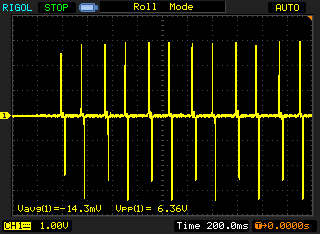
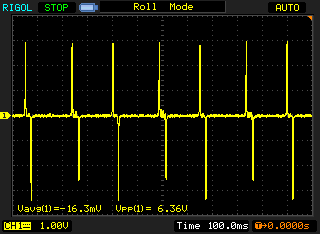


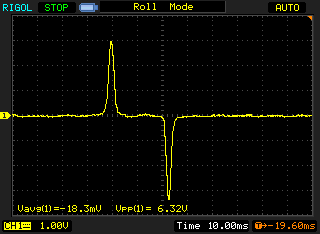
I checked eBay for photos of my alternator rotor, and sure enough it just has one gigantic tooth (see attached photo).
I'm actually a bit surprised this single tooth is provides enough information for the OEM CDI to calculate spark timing. My guess is that it measures the time between the positive and negative swing of that single tooth and uses that single measurement to infer RPM and crank position.
Re: 2009 Kawasaki KLX250SF
Posted: Sun Mar 28, 2021 10:07 pm
by cellularmitosis
There may be a silver lining here: because this is a single cylinder engine, there is actually a measurable slow-down on the compression stroke. If you look closely, you can even see this in the scope shots above: the pulses are not spaced evenly.
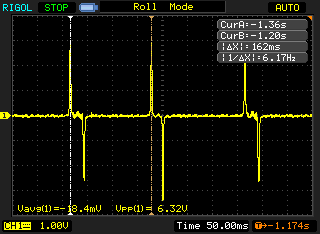
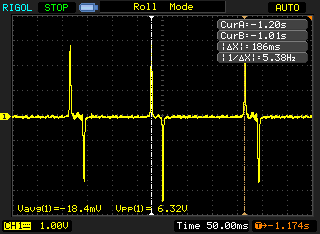
This means I can infer cam position based on this difference!

However, I would guess the difference in timing will be much more difficult to measure while running. This means I may be looking at establishing cam phase lock during cranking, and then just hoping I never desync (miss a crank pulse) for the duration of the ride. Not sure how realistic that is.
On the other hand, it may be relatively easy to drill into the valve cover and mount a sensor above one of the cam lobes.
Looks like used valve covers are a cheap eBay purchase, so little risk in that approach.
On the third hand, if I notice the bike start to run rough (due to cam desync), I could simply have a button to tell the ECU to jump to the opposite cam phase.
On the fourth hand, I don't see any sort of cam position sensor listed in the parts of the 2018 version of this bike (which is when they switched to EFI), so perhaps even the OEM doesn't care about cam phase, and this is a non-issue?
Re: 2009 Kawasaki KLX250SF
Posted: Sun Mar 28, 2021 10:13 pm
by cellularmitosis
From the scope shots, it looks like the average cranking period is about 175ms, which means the bike cranks at about 5.7Hz or about 340 RPM.
Re: 2009 Kawasaki KLX250SF
Posted: Thu Apr 01, 2021 10:13 am
by Fred
Gidday, good to see some activity here! :-D
Re your assertions about the single tooth trigger, I would assert that you're wrong about that.
It appears to be VR which has a few implications but the first issue and biggest is unrelated:
In a single cylinder 4 stroke engine you can only really reliably measure RPM over a 720 degree cycle or if 2 stroke it's a 360 cycle. Therefore they WILL be measuring RPM (if at all) from leading to leeading or trailing to trailing or both and using latest or average. If 4 stroke then they could do a rolling thing with those same numbers. If you try to do RPM from any sub part of the cycle on a single cylinder you'll get wildly wrong numbers. All engines are bad that way at low RPM, especially while cranking/kicking, but the less cylinders the worse, 1 being optimally bad, so to speak :-D
That said, one edge of that pattern will be appropriate exact timing for starting conditions so it can fire ON that signal. I have to use this in my "hotel hyundai" and then dial in the electronic timing from that to match. Most cars with better triggers can be rotated anywhere and electronically dialled in, but yours nees signal physical timing, and so does my crappy car :-D
Then under dynamic conditions you just time from there or from the other, to the desired point. Therefore chances are that one end or the other is directly fired from at a low-timing value eg 10 BTDC or so, and once running it's timed from one edge or the other as suits.
Does that make sense? I just spent over $2000 on a new machine and started drinking wine to numb the pain :-D
viewtopic.php?p=44849#p44849
Cheers, Fred.
Re: 2009 Kawasaki KLX250SF
Posted: Thu Apr 01, 2021 10:17 am
by Fred
Re VR, the rising and falling edges are so far apart that you get independent wave forms from an effectively reset state as the magnetic flux has gone in between. The distance between rising and falling zero crossings probably isn't particularly consistent because the real zero crossing is in the middle between them, but the circuit could be custom to interpret that signal with some threshold off and away from zero on each side, for eg. And in any case, for an OEM, rough enough timing is good enough. Maybe for you, too. You'd be surprised what they'll run on happily and how much abuse they can take on either end of the spectrum. Hope that helps.
Re: 2009 Kawasaki KLX250SF
Posted: Thu Apr 01, 2021 10:20 am
by Fred
I should read your post entirely before I hit submit! :-D
Re cam phase, they'll be software detecting it. You can't do wasted spark on odd numbers of cylinders so you have to know where you are. Maybe they fire and see what happens and then set it in software ah la "we're here!" or something. I was doing some work on a KTM race bike in Barcelona that needed the same sort of treatment. Maybe I had a private thread. If I did, I might move it somewhere where you can see it now that that's LONG gone.
